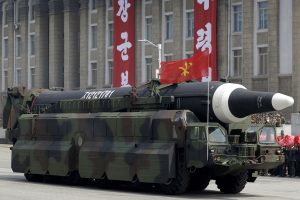North Korea launched one intermediate-range ballistic missile (IRBM) over Japan, South Korea’s Joint Chiefs of Staff (JCS) said on Tuesday. The missile flew about 4,500 km with an altitude of 970 km from Jagang, or Chagang, province of North Korea around 7:23 a.m. KST, the JCS said.
Tuesday’s missile test came three days after the previous launch, where North Korea fired two short-range ballistic missiles toward the waters off its east coast. The IRBM launch was North Korea’s fifth round of ballistic missile tests since September 25 – a span of just nine days – and its 37th ballistic missile launch this year.
On his way to work, South Korean President Yoon Suk-yeol told reporters that the North will face “a resolute response from our military, ally and the international community.” He also called North Korea’s IRBM launch “a reckless provocation.”
The South Korean military said that Pyongyang’s series of provocations would “strengthen deterrence and corresponding capabilities of the South Korea-U.S. alliance further” while isolating North Korea more from the international community.
South Korean Foreign Minister Park Jin spoke with his U.S. counterpart Antony Blinken to coordinate the joint response to the North’s missile threats. Kim Gunn, Seoul’s special representative for Korean Peninsula peace and security affairs, also had a phone call with his U.S. and Japanese counterparts and strongly condemned North Korea’s missile launch.
In a statement released late on Monday, U.S. time, Adrienne Watson, the National Security Council spokesperson for the White House, said “the United States strongly condemns the Democratic People’s Republic of Korea’s dangerous and reckless decision to launch a long-range ballistic missile over Japan.” Democratic People’s Republic of Korea is the official name of North Korea.
Although North Korea has repeatedly tested its ballistic missiles this year, Tuesday’s missile launch was more provocative for Japan, as a North Korean missile flew over the Japanese mainland for the first time since 2017. After detecting the launch, Japanese authorities warned residents in its northeastern regions, including Hokkaido island and Aomori prefecture, to seek shelter.
Japanese Prime Minister Kishida Fumio called the North’s missile launch is “very violent behavior.” Chief Cabinet Secretary Matsuno Hirokazu also held an emergency press conference after the North’s launch, which he said “could have a grave impact on the lives and livelihood of the Japanese people.” Matsuno also called the North’s missile launch “a grave challenge” to the security of Japan and the international community, while reiterating that the missile launch was a clear violation of multiple U.N. Security Council resolutions.
Under those resolutions, North Korea is banned from testing and developing ballistic missiles.
According to NHK reports, the Japanese government said that the North Korean missile flew approximately 4,600 km with an altitude of 1,000 km, a similar analysis to Seoul’s. Tokyo also confirmed that it was the seventh time a North Korean missile had flown over Japan. Despite the missile flying over Japanese territory, Japan “did not try to shoot down the missile,” triggering questions as to when Japan would shoot down a missile to defend its people.
Jeffrey Lewis, director of the East Asia Nonproliferation Program at the Middlebury Institute, said North Korea appeared to have tested its Hwasong-12 IRBM on Tuesday, based on the range, apogee, and flight time. Matsuno also gave a similar analysis during his press conference.
North Korea last tested its Hwasong-12 IRBM on January 30 of this year. That time the missile did not fly over Japan, as the apogee was intentionally set high.
A week after North Korea fired a ballistic missile over Japan in 2017, it carried out its sixth nuclear test. In this context, some experts say that the North’s seventh nuclear test is imminent. South Korea’s National Intelligence Service has predicted that the North’s next nuclear test could take place between October 17 and November 7. North Korea is also likely to test more advanced missiles in the next two weeks.
In a parliamentary audit on Tuesday, South Korean Defense Minister Lee Jong-sup said that North Korea had completed preparations for a nuclear test back in May. His Defense Ministry told legislators that North Korea has continued its efforts to advance its nuclear capabilities while restoring its Yongbyon nuclear complex. Along with this, North Korea has prepared to test its intercontinental ballistic missiles (ICBM) and submarine-launched ballistic missiles (SLBM), the ministry said.
North Korea’s state-controlled media have not reported any details of its missile tests for the last few months. Considering the performance of IRBM it launched on Tuesday, however, it may report the latest test to show off its missile capabilities on Wednesday.

































